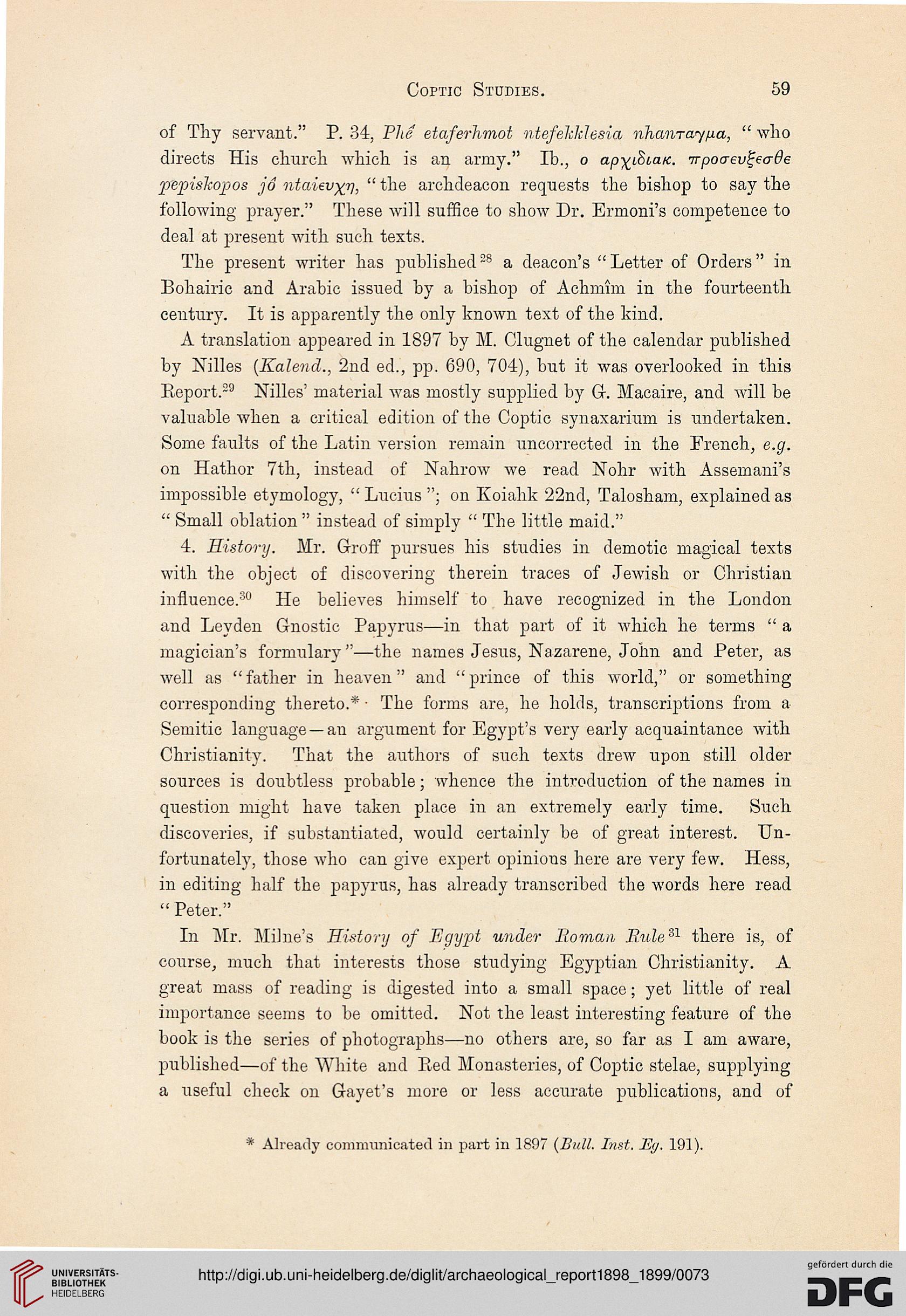Coptic Studies.
59
of Thy servant." P. 34, Phe etaferhmot ntefekklesia nhanrevyfia, " who
directs His church which is an army." Ib., o ap^ia/c. irpoaev^eade
ptpiskopos jo ntaievxr), " the archdeacon requests the bishop to say the
following prayer." These will suffice to show Dr. Errnoni's competence to
deal at present with such texts.
The present writer has published28 a deacon's " Letter of Orders" in
Bohairic and Arabic issued by a bishop of Achmim in the fourteenth
century. It is apparently the only known text of the kind.
A translation appeared in 1897 by M. Clugnet of the calendar published
by Nilles (Kalend., 2nd ed., pp. 690, 704), but it was overlooked in this
Eeport.29 Nilles' material was mostly supplied by G. Macaire, and will be
valuable when a critical edition of the Coptic synaxarium is undertaken.
Some faults of the Latin version remain uncorrected in the French, e.g.
on Hathor 7th, instead of Nahrow we read Nohr with Assemani's
impossible etymology, "Lucius"; on Koiahk 22nd, Talosham, explained as
" Small oblation " instead of simply " The little maid."
4. History. Mr. Groff pursues his studies in demotic magical texts
with the object of discovering therein traces of Jewish or Christian
influence/50 He believes himself to have recognized in the London
and Leyden Gnostic Papyrus—in that part of it which he terms " a
magician's formulary"—the names Jesus, Nazarene, John and Peter, as
well as "father in heaven" and "prince of this world," or something
corresponding thereto.* ■ The forms are, he holds, transcriptions from a
Semitic language —an argument for Egypt's very early acquaintance with
Christianity. That the authors of such texts drew upon still older
sources is doubtless probable; whence the introduction of the names in
question might have taken place in an extremely early time. Such
discoveries, if substantiated, would certainly be of great interest. Un-
fortunately, those who can give expert opinions here are very few. Hess,
in editing half the papyrus, has already transcribed the words here read
" Peter."
In Mr. Milne's History of Egypt under Roman Eule31 there is, of
course, much that interests those studying Egyptian Christianity. A
great mass of reading is digested into a small space; yet little of real
importance seems to be omitted. Not the least interesting feature of the
book is the series of photographs—no others are, so far as I am aware,
published—of the White and Pi,ed Monasteries, of Coptic stelae, supplying
a useful check on Gayet's more or less accurate publications, and of
* Already communicated in part in 1897 (Bull. Inst. Ey. 191).
59
of Thy servant." P. 34, Phe etaferhmot ntefekklesia nhanrevyfia, " who
directs His church which is an army." Ib., o ap^ia/c. irpoaev^eade
ptpiskopos jo ntaievxr), " the archdeacon requests the bishop to say the
following prayer." These will suffice to show Dr. Errnoni's competence to
deal at present with such texts.
The present writer has published28 a deacon's " Letter of Orders" in
Bohairic and Arabic issued by a bishop of Achmim in the fourteenth
century. It is apparently the only known text of the kind.
A translation appeared in 1897 by M. Clugnet of the calendar published
by Nilles (Kalend., 2nd ed., pp. 690, 704), but it was overlooked in this
Eeport.29 Nilles' material was mostly supplied by G. Macaire, and will be
valuable when a critical edition of the Coptic synaxarium is undertaken.
Some faults of the Latin version remain uncorrected in the French, e.g.
on Hathor 7th, instead of Nahrow we read Nohr with Assemani's
impossible etymology, "Lucius"; on Koiahk 22nd, Talosham, explained as
" Small oblation " instead of simply " The little maid."
4. History. Mr. Groff pursues his studies in demotic magical texts
with the object of discovering therein traces of Jewish or Christian
influence/50 He believes himself to have recognized in the London
and Leyden Gnostic Papyrus—in that part of it which he terms " a
magician's formulary"—the names Jesus, Nazarene, John and Peter, as
well as "father in heaven" and "prince of this world," or something
corresponding thereto.* ■ The forms are, he holds, transcriptions from a
Semitic language —an argument for Egypt's very early acquaintance with
Christianity. That the authors of such texts drew upon still older
sources is doubtless probable; whence the introduction of the names in
question might have taken place in an extremely early time. Such
discoveries, if substantiated, would certainly be of great interest. Un-
fortunately, those who can give expert opinions here are very few. Hess,
in editing half the papyrus, has already transcribed the words here read
" Peter."
In Mr. Milne's History of Egypt under Roman Eule31 there is, of
course, much that interests those studying Egyptian Christianity. A
great mass of reading is digested into a small space; yet little of real
importance seems to be omitted. Not the least interesting feature of the
book is the series of photographs—no others are, so far as I am aware,
published—of the White and Pi,ed Monasteries, of Coptic stelae, supplying
a useful check on Gayet's more or less accurate publications, and of
* Already communicated in part in 1897 (Bull. Inst. Ey. 191).





